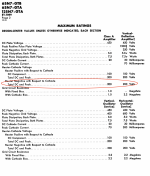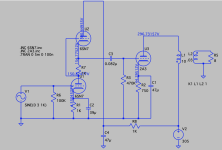If it's a DAC it could be OK. If it's a preamp it would need a low output impedance, so not a valve preamp unless it had a mu stage or cathode follower or step-down or the like.
Most of the source for this 2A3 amp will be DAC and CD Player, so I'd need volume control in front of the 1:4 SUT, unless I use my MacBook laptop, which streams Tidal and has a decent onboard DAC (and volume control). The laptop is what I've been using as source for all the experiences posted here.
I made one line preamp that's a 6SN7 cathode follower which puts out about 4.5Vrms. That could work well in front of a 1:4 SUT with 600R primary, I gather?
I'm about to make a 26 line preamp with a step-down output transformer that will put out about 3V. Seems a bit silly to place a step-down transformer in front of a step-up transformer. But then again I've done much dumber things in my time.
Did you try the 6SN7 in SRPP as of yet, jdrouin?
I have some vacation time coming up and the plan is to put together a 2A3 amplifier. Originally I was going for a 12AY7-based circuit but I've been reading your experiences of the 6SN7 with interest and I have some 6SN7s on hand.
I don't have any 6SL7s available though, otherwise I'd give that a try.
I have some vacation time coming up and the plan is to put together a 2A3 amplifier. Originally I was going for a 12AY7-based circuit but I've been reading your experiences of the 6SN7 with interest and I have some 6SN7s on hand.
I don't have any 6SL7s available though, otherwise I'd give that a try.
My journey to a 2 stage all-DHT amp with SUT was slow and deliberate and I changed many, many things on the way and did an enormous amount of careful comparative listening. So for me, I'm not going back. The DHT driver stays because it sounds better than IDHTs. No argument about that. The 2 stage topology stays because it's much cleaner. No argument about that either. So by default I need a step-up on the input, or a DAC putting out more than 2V. I wouldn't rule out a third DHT stage if it were the output of the DAC. I haven't done any work on DACs but I might since I just fired up a Soekris that outputs 1.4V which is marginal for my system. My AK4490 DAC is 2V out and OK. That has an op-amp output. But on principal I want an amp that works with 2V input, since that's the standard.Most of the source for this 2A3 amp will be DAC and CD Player, so I'd need volume control in front of the 1:4 SUT, unless I use my MacBook laptop, which streams Tidal and has a decent onboard DAC (and volume control). The laptop is what I've been using as source for all the experiences posted here.
I'm about to make a 26 line preamp with a step-down output transformer that will put out about 3V. Seems a bit silly to place a step-down transformer in front of a step-up transformer. But then again I've done much dumber things in my time.
I've always put forward the argument that you should try using the 26 as the driver for the 2a3 and put a SUT in front of it. Step-down followed by step-up doesn't make any sense to me. Many years ago I abandoned the whole concept of "a preamp" which I consider an anachronism. I just see "amplification" as a number of stages. What kind of chassis you put them in is a personal choice, but "amplification" is obviously a direct chain from input DAC to output speakers.
I don't use a volume control - another anachronism for me. All volume is in software on my Mac.
Thanks for the journey narrative, as always, Andy. Understood.
I’ll want this amp to play to a variety of sources including vinyl records, so a volume control will need to be in the chain somewhere. Come to think of it, my phono preamp has an adjustable-gain buffer stage that can function like a volume control, though I’d have to do listening tests to see how feasible that is. Actually now I recall that my CD player has line out attenuation too.
So maybe just a little standalone passive volume control to emplace when needed for a non-adjustable source like my standalone DAC.
I’ll want this amp to play to a variety of sources including vinyl records, so a volume control will need to be in the chain somewhere. Come to think of it, my phono preamp has an adjustable-gain buffer stage that can function like a volume control, though I’d have to do listening tests to see how feasible that is. Actually now I recall that my CD player has line out attenuation too.
So maybe just a little standalone passive volume control to emplace when needed for a non-adjustable source like my standalone DAC.
I might still try 12AY7 because it looks good on paper.Did you try the 6SN7 in SRPP as of yet, jdrouin?
I have some vacation time coming up and the plan is to put together a 2A3 amplifier. Originally I was going for a 12AY7-based circuit but I've been reading your experiences of the 6SN7 with interest and I have some 6SN7s on hand.
I don't have any 6SL7s available though, otherwise I'd give that a try.
If there’s time tonight, I’ll set up 6SN7 SRPP. Might be another day or two though. Will report back soon!
Huh. Thanks for that. This morning I started trying to learn about non-potentiometer volume controls, so this will give me something concrete think with.
how do you wire the 1140 LN C - do you parallel the 500ohm secondary? I have not used an sut before.Yes, that one. Don audio is €45 each. That's very good value. It's a studio quality transformer containing nickel.
This 1:4 SUT opened the doors for me to 2 stage all-DHT amps. I'm never going back - this is the end game. Ale Moglia uses a similar setup - Lundahl LL7903 into 47 into 300b. The 1140-LN-C is considerably cheaper and may well be of a similar quality - I haven't compared them. But I'm happy with the Hammond.
https://www.bartola.co.uk/valves/2020/07/25/300b-se-amp-47-driver/
And is it possible to use battery bias with it?
For 1:4 it's wired as shown. I haven't used battery bias but I'm sure somebody can advise. I always use filament bias for DHTs.

Yeah, I'm using the Hammond 1140-LN-Cs with battery grid bias in the directly coupled amp I've got on the breadboard.And is it possible to use battery bias with it?
Just wire the orange wire (positive output from the Hammond) to the positive battery terminal and the negative battery terminal either directly to the tube grid or to the grid stopper resistor if you're using one.
Thanks! I'll try it with a 26-2A3 headphone amp so I can drive speakers, with the 26 in battery bias. I had it in filament bias but I found battery bias gave me better bass.
I have used battery bias, with voltages from 3V to 96V, for various tube amplifier circuits.
The trick is how you arrange the circuit around the batteries so that the only battery current that ever occurs, is when the grid goes positive with respect to the cathode or the filament-'cathode'.
Those circuits were designed to work with signal voltages that never draw grid current. Class A1, not Class A2.
And that small grid current if the volume is too high, only charges the battery, it does not discharge the battery.
I used those batteries for years.
I no longer use battery bias.
Just my story over time.
The trick is how you arrange the circuit around the batteries so that the only battery current that ever occurs, is when the grid goes positive with respect to the cathode or the filament-'cathode'.
Those circuits were designed to work with signal voltages that never draw grid current. Class A1, not Class A2.
And that small grid current if the volume is too high, only charges the battery, it does not discharge the battery.
I used those batteries for years.
I no longer use battery bias.
Just my story over time.
I'm installing the 6SN7 SRPP on the breadboard now. Going to start with 1K resistors for an operating point in each section of 150Vak/4.5mA.
I was assuming that I would need to elevate the 6SN7 heater voltage so that the cathode of the top triode does not exceed the heater-cathode limit (as you need to do with 6SL7). However, the datasheet says "Heater negative with respect to cathode -- 200 volts" (schemo and datasheet screenshots attached). If the heater transformer center tap is grounded and the top cathode is at about 155V above ground, then I don't need to elevate the heater voltage, correct?
Seems like a silly question but for some reason my gut doesn't trust it. Maybe it's time to sleep.
I was assuming that I would need to elevate the 6SN7 heater voltage so that the cathode of the top triode does not exceed the heater-cathode limit (as you need to do with 6SL7). However, the datasheet says "Heater negative with respect to cathode -- 200 volts" (schemo and datasheet screenshots attached). If the heater transformer center tap is grounded and the top cathode is at about 155V above ground, then I don't need to elevate the heater voltage, correct?
Seems like a silly question but for some reason my gut doesn't trust it. Maybe it's time to sleep.
Attachments
Some people including myself tie the heater center tap to the top of the power amplifier cathode resister.If the heater transformer center tap is grounded and the top cathode is at about 155V above ground, then I don't need to elevate the heater voltage, correct?
That elevates the heater cct somewhat & relieves to a degree the concern you have.
The amp here in the workshop built in 1968 runs that way everyday, never a problem. 👍
Like we tend to do to politicians and preachers, we tend to have a TBMF (touching, but misguided, faith) in some valve specs from old manuals. Some things are very process sensitive, including excess noise, grid current and heater-cathode relations. Basically, these many decades later, modern production has no real relation to the specs in some old valve manual, and original valves from that manufacturer and era are not necessarily the same anymore themselves. We long for predictability, but we can't always get what we want.
But if you try sometimes,
Chris
But if you try sometimes,
Chris
Decouple from the cathode with something like 100K & bypass that to common with 0,1 micrioF.Some people including myself tie the heater center tap to the top of the power amplifier cathode resister.
That elevates the heater cct somewhat & relieves to a degree the concern you have.
That way if there is a problem in the heater line it does not remove the bias from the power audio tube.
I'd guess that for the vast majority of amplifiers built by folk viewing this page, this is the bestest-and-enoughness choice. Within +/- 100VDC, worry about something else.
Usually, maybe, often, but that's life,
Chris
Usually, maybe, often, but that's life,
Chris
- Home
- Amplifiers
- Tubes / Valves
- Developing a 2A3 SET

